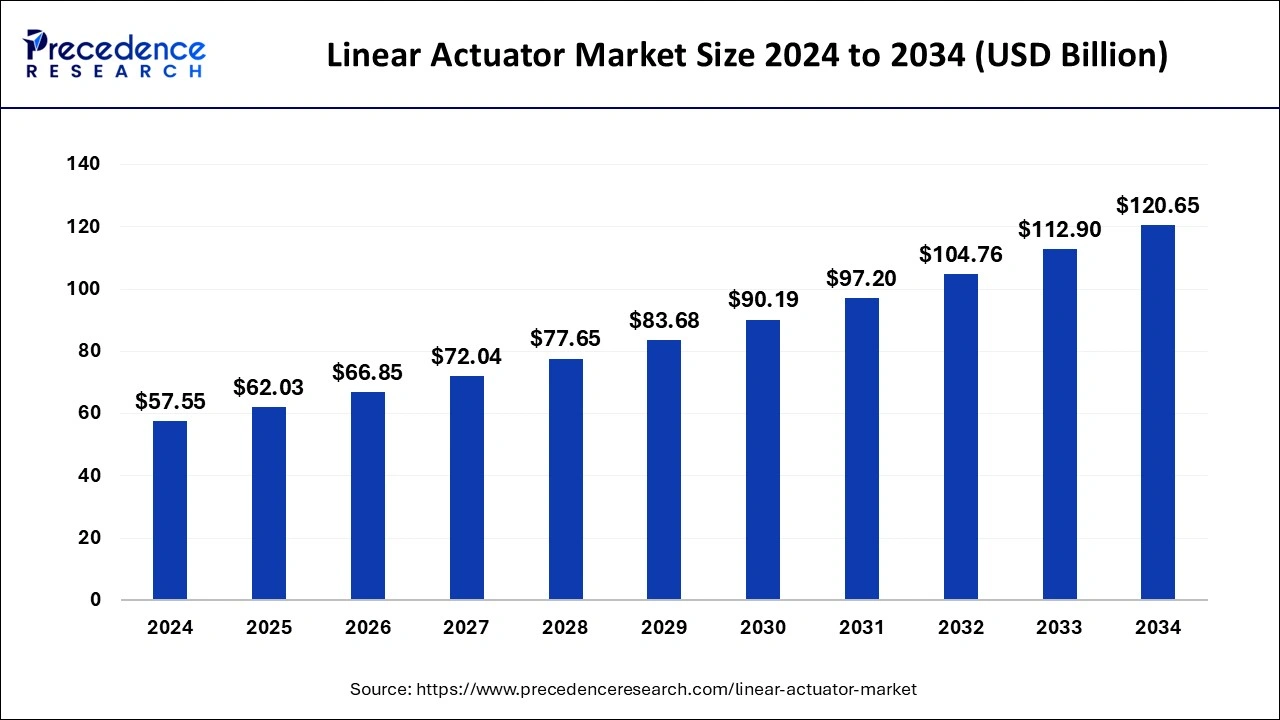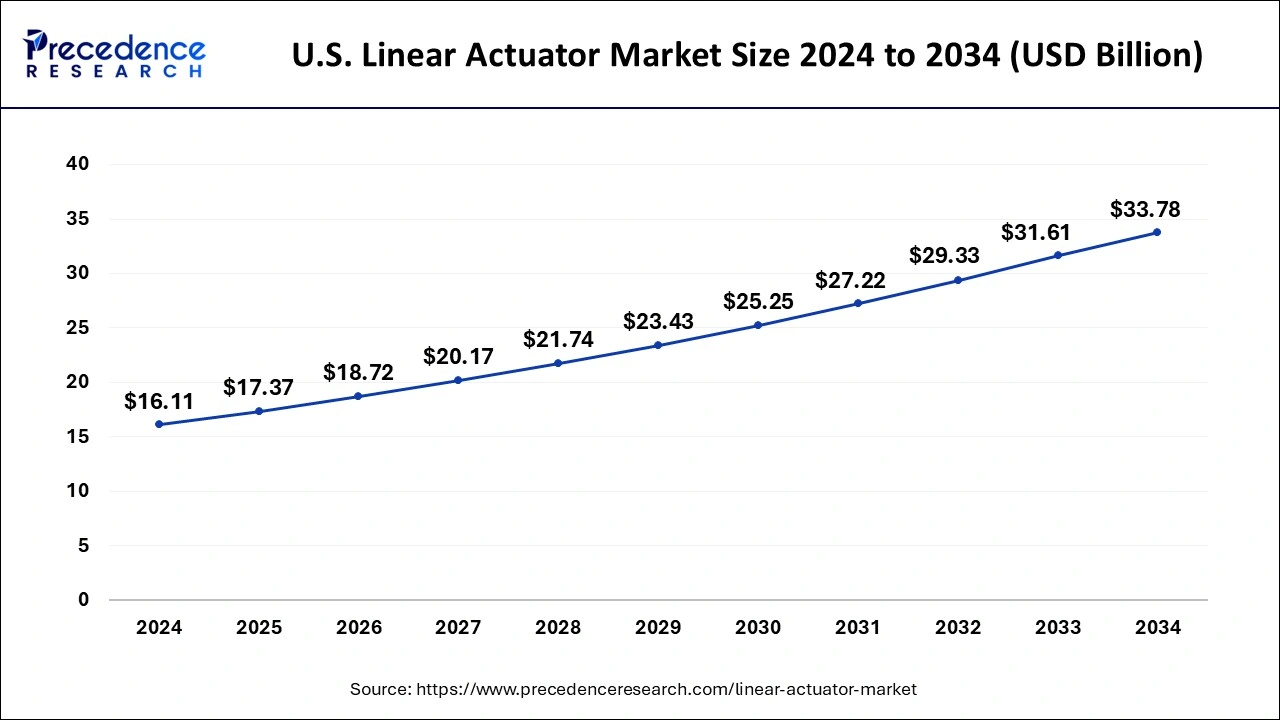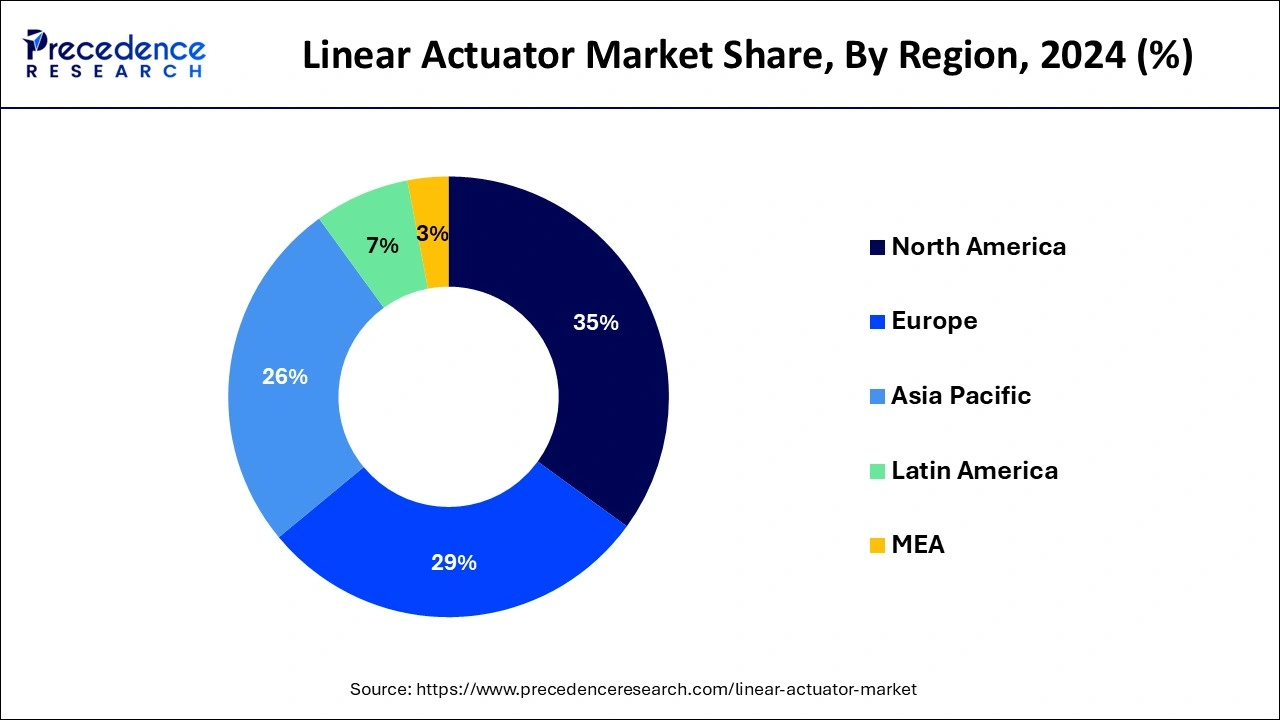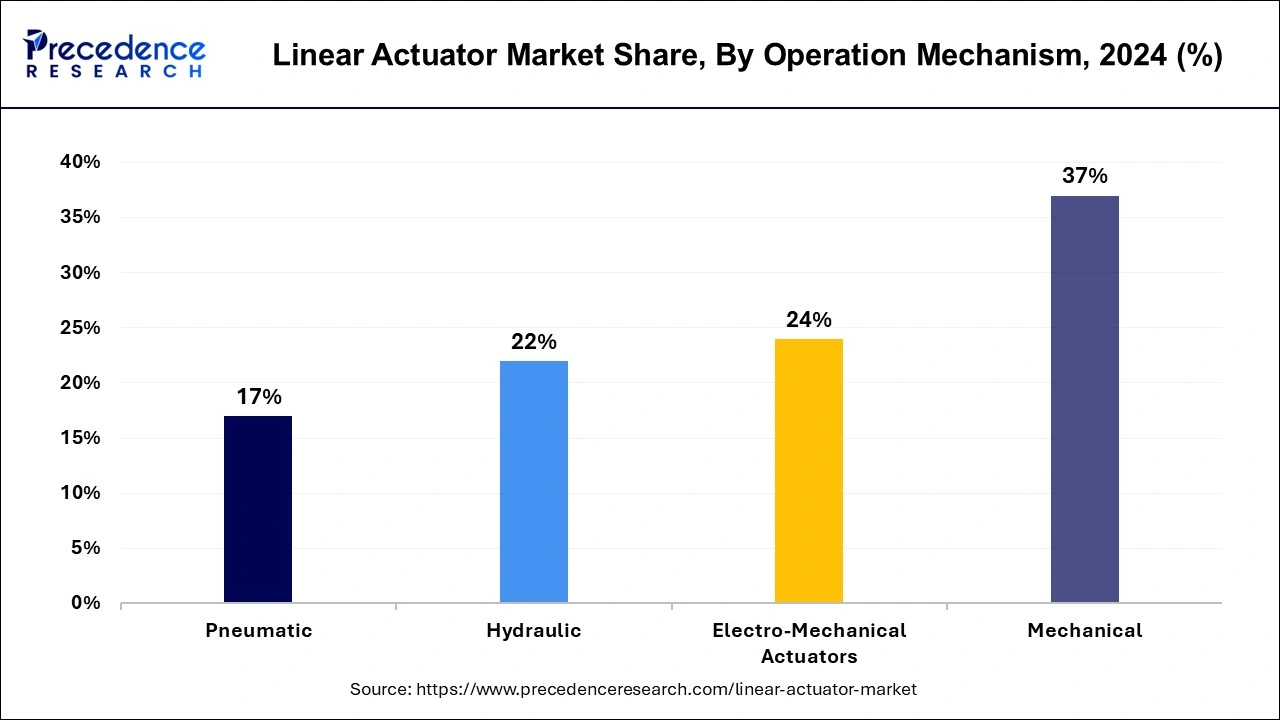August 2024
The global linear actuator market size is calculated at USD 62.03 billion in 2025 and is forecasted to reach around USD 120.65 billion by 2034, accelerating at a CAGR of 7.68% from 2025 to 2034. The North America linear actuator market size surpassed USD 20.14 billion in 2024 and is expanding at a CAGR of 7.69% during the forecast period. The market sizing and forecasts are revenue-based (USD Million/Billion), with 2024 as the base year.
The global linear actuator market size was estimated at USD 57.55 billion in 2024 and is predicted to increase from USD 62.03 billion in 2025 to approximately USD 120.65 billion by 2034, expanding at a CAGR of 7.68% from 2025 to 2034 The need for linear actuators in the manufacturing, automotive, aerospace, healthcare, and other sectors has risen in tandem with the expansion of industries worldwide, propelling the market's growth.

The U.S. linear actuator market size was estimated at USD 16.11 billion in 2024 and is projected to surpass around USD 33.78 billion by 2034 at a CAGR of 7.70% from 2025 to 2034.

North America held the largest share of the linear actuator market. In order to provide accurate movement and control in a variety of machinery and equipment, there is an increasing demand for linear actuators due to the automation of manufacturing and production processes. In robotics applications, such as industrial robots and service robots utilized in logistics, healthcare, and other fields, linear actuators are essential components. The growing robotics sector is driving the demand for sophisticated linear actuator systems.
Manufacturers of linear actuators are seeing opportunities as more vehicles switch to electric ones, especially in areas like automatic doors, seat adjustment mechanisms, and electric power steering systems. The design and development of linear actuators are influenced by regulatory requirements and environmental factors, especially with regard to energy efficiency, sustainability, and compliance with industry standards.

Asia Pacific has accounted revenue share of around 29% in 2024. Asia Pacific, especially China, Japan, South Korea, and India, has been rapidly industrializing and implementing automation technology in a wide range of industries. The market is expanding because linear actuators are essential to automation operations.
The Asia Pacific linear actuator market is expanding rapidly as a result of government programs that stimulate technological innovation, industrial automation, and improved manufacturing capacities. Numerous significant companies in the linear actuator industry, as well as up-and-coming suppliers and manufacturers, are based in the region. In order to obtain a competitive edge in the market, there is fierce competition, which drives ongoing product development, technical innovation, and strategic partnerships.
Due to their ability to precisely control linear motion, linear actuators are essential to industrial automation. The demand for linear actuators in the manufacturing and processing industries is anticipated to continue to be robust due to the ongoing trend toward industrial automation and Industry 4.0 efforts. In order to achieve precise movement in robotic grippers, arms, and other devices, linear actuators are essential parts of robotics.
High-performance linear actuators will probably become more and more in demand as robotics applications spread throughout sectors like healthcare, logistics, and automobiles. The linear actuator market is being driven by the increasing use of smart home technologies and building automation systems in applications such as motorized window blinds, movable furniture, and automated doors and windows.
It is anticipated that the need for linear actuators with accurate control and dependability will increase as long as healthcare facilities keep investing in cutting-edge medical technologies. Electric car components such as seat adjustments, trunk doors, and charging port mechanics all require linear actuators.
The need for linear actuators in the automotive industry is anticipated to rise in response to the increasing acceptance of electric vehicles and the ongoing attempts to enhance their convenience and efficiency. Advanced linear actuators with features like more precision, more load capacity, enhanced energy efficiency, and integration with IoT platforms for remote monitoring and control are the focus of manufacturers.
| Report Coverage | Details |
| Growth Rate from 2025 to 2034 | CAGR of 7.68% |
| Market Size in 2025 | USD 62.03 Billion |
| Market Size by 2034 | USD 120.65 Billion |
| Largest Market | North America |
| Base Year | 2024 |
| Forecast Period | 2025 to 2034 |
| Segments Covered | By Operation Mechanism and By End-user Industry |
| Regions Covered | North America, Europe, Asia-Pacific, Latin America, and Middle East & Africa |
E-commerce growth
Manufacturers of linear actuators can reach a worldwide market through e-commerce platforms, eliminating the need to set up actual distribution networks in each location. Companies in the linear actuator market are able to expand their consumer base and access new markets because of this increased reach. Inventory management systems and online storefronts can be integrated to help businesses optimize stock levels, cut lead times, and guarantee on-time product delivery to customers.
Because e-commerce gives consumers access to product details, reviews, and pricing, it promotes openness in the linear actuator market. Producers and distributors can use this data to discover new market trends, obtain insightful knowledge about consumer preferences, and adjust their product lineups accordingly.
Dependency on end-user industries
Applications for the linear actuator market can be found in automobiles' convertible tops, power windows, sunroofs, and seat automation systems. The need for linear actuators is directly impacted by the car industry's need for automation, safety, and comfort features. In consumer electronics items like game consoles, cellphones, cameras, and household appliances, linear actuators are used for features like autofocus and magnification, as well as opening and closing mechanisms.
For accurate movement and control, linear actuators are used in construction equipment, including excavators, cranes, and lifts. They are also used in infrastructure projects for things like solar panels, gates, and barrier placement. Technological developments in energy production and distribution, regulatory requirements, and energy demand all have an impact on the linear actuator market demand.
Renewable energy sector
Solar tracking systems, which maximize the amount of sunlight absorbed throughout the day by optimizing the position of solar panels or mirrors, heavily rely on linear actuators. In order to maximize energy capture and efficiency, these actuators modify the angle or pitch of the blades to optimize their location with respect to the direction of the wind.
Actuators provide accurate control over these components' movements, which makes water management and energy generation more efficient. Linear actuators are used in wave and tidal energy converters to move different parts, like turbines or buoys, in order to capture energy from tidal currents or ocean waves efficiently.
The mechanical segment held the largest share of the linear actuator market. The physical parts of linear actuators that translate rotary motion into linear motion are usually referred to as the mechanical section of the linear actuator market. Electromechanical devices called linear actuators are used to produce motion in a straight line. Numerous sectors and applications, including robotics, manufacturing, automotive, healthcare, aerospace, and more, heavily rely on them.

The main methods for transforming rotary motion into linear motion are as follows. Whereas ball screws employ ball bearings to lower friction and increase efficiency, lead screws use threads to translate rotational action into linear motion. Shafts and bearings are frequently used in linear actuators to support and precisely guide linear motion.
The hydraulic segment has held a 22% revenue share in 2024 and it is also expected to hold a considerable share of the linear actuator market. The method by which hydraulic energy is transformed into mechanical motion powers hydraulic linear actuators. Usually, they are made up of a hydraulic fluid, piston, and cylinder. A force that moves the piston and produces linear motion is created when hydraulic pressure is supplied to one side of the piston.
Tasks like lifting, pushing, tugging, and adjusting the position of different mechanical parts can all be done using this action. Because they can produce higher force outputs than other linear actuator types, hydraulic actuators are well-suited for heavy-duty applications like industrial automation, agricultural gear, and construction equipment.
The automotive segment held the largest market share in 2023 and is expected to continue this dominance throughout the forecast period. This is due to the rising demand for automobiles and increasing investment in healthcare. The linear actuator market plays a vital role in the automotive industry, and their adoption has increased globally along with the growing automotive sector. With the continued increase in global demand for automobiles, automation in their manufacturing is also expanding.
Linear actuators are essential components used in automotive applications of various sizes and shapes, ranging from small to large. Many automobile manufacturers use robots to perform tasks such as clamping and fixing, spot welding, and assembly pressing. With the increased adoption of robots in the automotive industry, the use of electric linear actuators has become critical, which will boost sales. Linear actuators are used in a wide range of automotive applications, including hoods, trunks, tailgates, tonneau covers, and rumble seats.
By Operation Mechanism
By End-user Industry
By Geography
For inquiries regarding discounts, bulk purchases, or customization requests, please contact us at sales@precedenceresearch.com
No cookie-cutter, only authentic analysis – take the 1st step to become a Precedence Research client
August 2024
July 2024